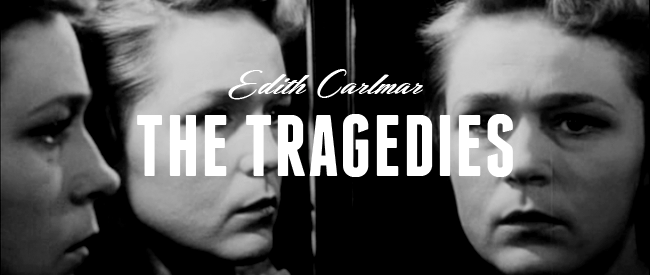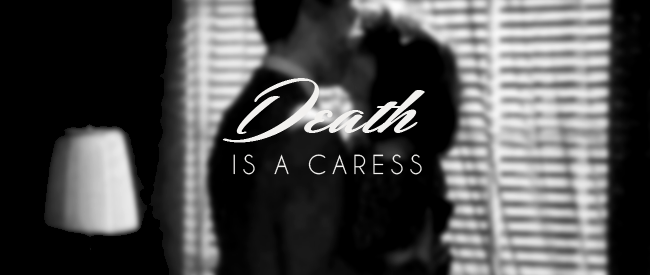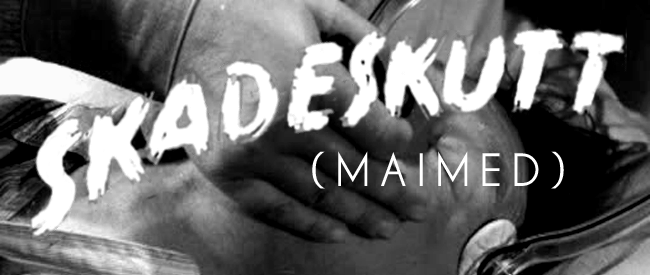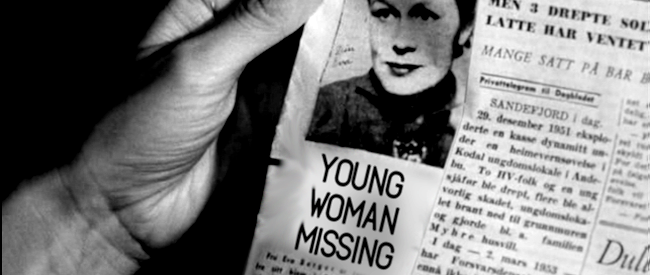
Special thanks to the Norwegian Film Institute (NFI).
A singularly witty and dexterous auteur, Norway’s pioneering female filmmaker Edith Carlmar is ripe for a reappraisal in world cinema. Carlmar and her husband Otto co-managed their own production company, Carlmar Film A/S, with which they collaborated with a diverse community of technicians, artists and performers – including the then-teenage Liv Ullman, whose debut lead at 21 was Edith’s final film as director, The Wayward Girl. Making ten movies in as many years, the Carlmars built an astonishing resume in the 1950s before abandoning filmmaking forever when they were at the top of their game.
Today Edith’s legacy suggests a nearly clear split between flinty, ice-cold film noirs – often evincing a rare female perspective – and romantic comedies that’ll make your jaw drop even today with their sexual candor. She was in particular a master of eroticized close-ups and devastating quiet moments, never flinching from emotions (pleasurable or painful) most American directors wouldn’t touch with a fork.
That said, Carlmar Film A/S was an unabashedly commercial enterprise, at a time of deeply felt prudishness in Norway. The Carlmars made hits for a popular audience, and proudly paid all their grants back to the government. Never betraying her blue-collar roots, Edith left the distribution rights to her entire catalog to FILMVETERANENE, a union of Norwegian industry veterans. Alongside them, Spectacle is thrilled to team up with the Norwegian Film Institute to blow the dust off these classics of Scandinavian cinema this autumn.
 DEATH IS A CARESS
DEATH IS A CARESS
(Døden er et kjærtegn)
dir. Edith Carlmar, 1949
88 mins. Norway.
In Norwegian with English subtitles.
MONDAY, NOVEMBER 4th – 7:30PM
FRIDAY, NOVEMBER 15th – 10PM
Carlmar’s fierce and mesmerizing debut film follows a Erik (Claus Wiese), a young auto mechanic, and his torrid love affair with Sonja (Bjørg Riiser-Larsen) – an older, married woman. Death Is A Caress luxuriates in beautifully staged meetings and whisperings, private moments refiltered into Erik’s voice-over account of how the affair swallowed up his life. Carlmar’s ensemble always has a wisecrack ready in response for him, but this conventional linear device also allows the filmmakers to throw their weight into wordless, lush sequences of huge import: benders, moments of heated passion, curious interior observations.
Pressed against the stoically clueless Erik, Sonja’s catty, desperately lonely femme fatale turns the film into a grand game of emotional chess as they plunge deeper into their doomed romance. Carlmar would perhaps take future subject matters more seriously in her aesthetic, but it hardly matters: Caress is haunting in how it executes one luminous, golden-era pirouette after another. Ingeniously wry, Carlmar’s filmmaking never fully tips its hat to the audience; if the film has a noir’s backbone, its filling is closer to the knotted domestic drama of Tennessee Williams. Through Erik’s virginal eye, Caress is breathtakingly sensual, making his first loss of innocence its own champagne-drunk landscape.

MAIMED
(Skadeskutt)
dir. Edith Carlmar, 1951
87 mins. Norway.
In Norwegian with English subtitles.
WEDNESDAY, NOVEMBER 6th – 10PM
WEDNESDAY, NOVEMBER 27th – 10PM
Neither a thriller nor a weepie, Maimed introduces itself as a case study, bookended with comments from a jovial old psychiatrist. If Carlmar’s first film is baroque, Maimed is decidedly a chamber piece, an attempt to conjure thrashing waves of emotion from confined spaces and situations. Carsten Winger stars as Einar Wang, an architect who keeps himself distant and cold from life; after he attempts suicide, he’s paralyzed and placed in an asylum. His wife Else (Eva Bergh) uncovers her husband’s soul-crushing depression, spurred by a deep neurosis about his inability to have children – and the hidden fact of a girlfriend’s abortion earlier in his life.
Growing impatient with the couple’s inability to conceive as Einar improves, Else soon solicits the help of her husband’s best friend. Einar takes incremental steps towards re-entering society as a formerly insane person, but the new baby – indeed, the cloud of hereditary insanity floating over their household – drives him mad all over again. Meanwhile Else, persuades herself her choice was ultimately better for them both – her feelings between Rolf, Einar and her infant son a little too well compartmentalized.
Building to an explosive conclusion, Maimed avails itself a dark underside of life-wearinesss. The asylum scenario sees the Carlmars cracking a bevy of Norwegian society’s veneers, giving some of the most memorable lines to addicts and sociopaths (and lumping the doctors in with them.) The exploration of madness as a contaminant that thrives on self-awareness sets the film worlds apart from its contemporaries, and Otto Carlmar’s script doesn’t shy in its plummet into reality.
 YOUNG WOMAN MISSING
YOUNG WOMAN MISSING
(Ung frue forsvunnet)
dir. Edith Carlmar, 1953
90 mins. Norway.
In Norwegian with English subtitles.
SATURDAY, NOVEMBER 9th – 10PM
FRIDAY, NOVEMBER 15th – 7:30PM
Perhaps the saddest film in this series, Young Woman Missing is also Carlmar’s most political, transferring the audience’s sympathies from husband to wife after reevaluating the life of its titular young woman. When well-to-do academic Arne (Adolf Bjerke) returns home from a “men’s weekend” to find his wife Eva (Astri Jacobson) missing, he calls the police. They eventually begin to uncover facts about Eva’s earlier life – including that she was pregnant – and grapple with the question of how much to involve her prudish, unsympathetic husband.
Carlmar’s depiction of Eva’s marriage to Arne is little less than a straitjacket of classist and sexist overexpectation, causing him to crush the very thing in her that attracted him in the first place: her innocence. That said, Young Woman Missing also allows the audience to be surprised by Eva herself, and her jejune traipse into drug addiction during an earlier romance.
Carlmar’s focus on the wellbeing of her characters and their decision-making processes makes the film a quixotic – as opposed to punitive – tragedy. Ultimately a story of good intentions and overpowering weakness, the sum result is less Hollywood style finger-wagging than a ragged inscription of a human life, wrapped in the haunting beauty of Oslo’s frigid weather.
